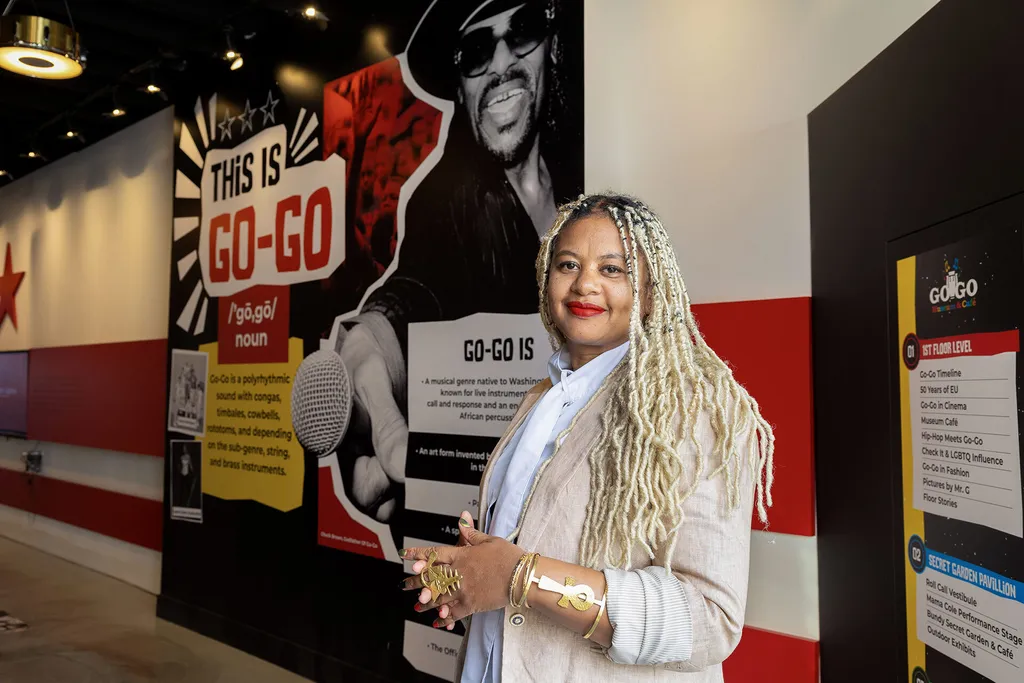- February 06, 2025
- By Sala Levin ’10
What do ’90s slacker icon Beck, pioneering New York City female hip-hop group Salt-N-Pepa and reigning musical queen Beyoncé have in common? They’ve all been influenced by a genre of music born and raised in the nation’s capital: go-go.
On Feb. 18, the Go-Go Museum and Café will open its doors, letting visitors listen to, dance along with and learn about the percussive music that’s unique to Washington, D.C.
“At its core, this is a place of communion,” said Natalie Hopkinson M.A. ’99, Ph.D. ’07, the museum’s curator and co-founder. “It’s a place of celebration. It’s a place of upholding traditions that have been in Black communities for centuries.”
The museum, funded by a combination of city grants and private donations, tells the history of go-go’s creation and development, highlights some of the genre’s key players, hosts a recording studio and concert spaces, and explores how go-go has shaped artists from all corners of the musical world.
It also examines how the style has served as a scapegoat for violence and drugs; in 1987, the D.C. Council passed legislation that placed a curfew on young people going to go-go music halls, purportedly to curb violent incidents that had taken place at some of them.

“That put a target on go-go’s back,” said Hopkinson, now an associate professor of media, democracy and society at American University.
Go-go, characterized by conga drums, layers of horns and its interactive live performances, was created by the late D.C. musician Chuck Brown, whose biggest hit, 1979’s “Bustin’ Loose,” went on to be sampled by the rapper Nelly in millennial favorite “Hot in Herre.” Since Brown’s era, go-go has lived in venues throughout D.C. and Prince George’s County.
“If you know, you know. And if you don’t know, I feel sorry for you,” said D.C. Council member Kenyan R. McDuffie at the Go-Go Museum’s soft launch in November.
Though Hopkinson came to D.C. from Florida to attend Howard University, she didn’t know until her career in journalism took her to The Washington Post in 1999. There, she covered Prince George’s County; an assignment to put together an arts guide brought her into the world of go-go. “I got obsessed with it,” she said. So obsessed, in fact, that when she started her Ph.D. in journalism and public communication at the University of Maryland, she wrote her dissertation on go-go, resulting in the 2012 book “Go-Go Live: The Musical Life and Death of a Chocolate City.”
During her time at The Post, Hopkinson met local activist and music promoter Ron Moten, another go-go devotee. In 2019, tenants of a luxury apartment complex at the intersection of Florida Avenue and 8th Street NW began to complain that a nearby cell phone store was blaring go-go music—which it had done for years. The situation sparked a conversation about gentrification, and in response, Hopkinson and Moten created Don’t Mute DC, a movement to advocate for go-go music and other local causes. They also began to dream up the idea of a museum dedicated to go-go.
In the Anacostia space near a juice bar, a coffee shop and an outpost of local restaurant chain Busboys and Poets, visitors can listen to songs featuring sampled go-go beats, pull up video clips on an interactive timeline of go-go in D.C., and see African instruments that made their way into the musical style. Even a trip to the bathroom proves more than functional: the walls are adorned with definitions of go-go terms like “E.U. Freeze” and “numb to the max.”
Hopkinson hopes that museum-goers will leave not just with deeper knowledge about go-go, but with a sense of pride in the style that became the official music of D.C. in a 2020 D.C. Council act. “We’re providing opportunities to continue to do the narrative change around go-go and liberate people’s minds from some of the very racist tropes and assumptions that there were about Black people, Black culture, Black spaces,” she said. “Go-go is not bad or shameful—it’s just music.”
The Go-Go Museum & Café will open to the public on Feb. 18 at 1920 Martin Luther King Jr. Ave. SE, Washington, D.C. 20020. Find more information at gogomuseumcafe.com.
This is one of a series of Maryland Today features during Black History Month celebrating Terp faculty, staff, students and alums.
Topics
People